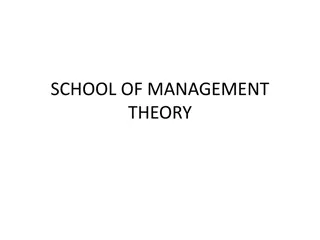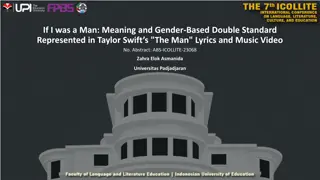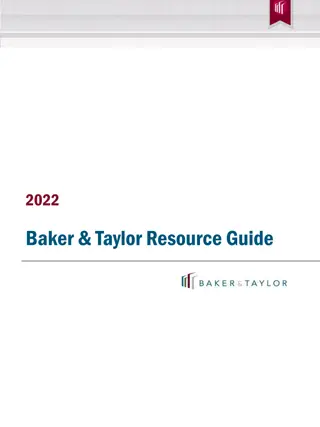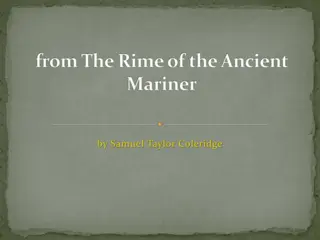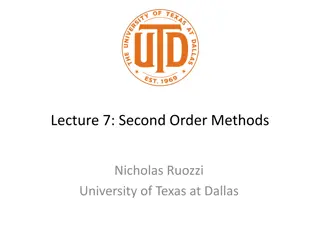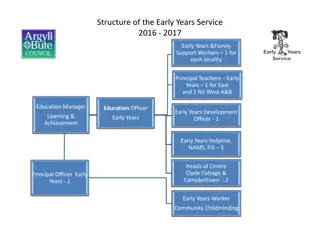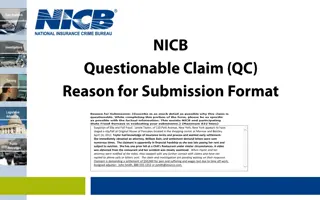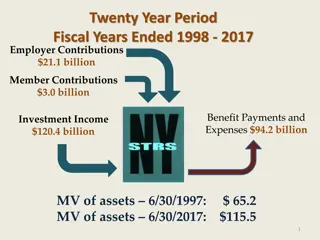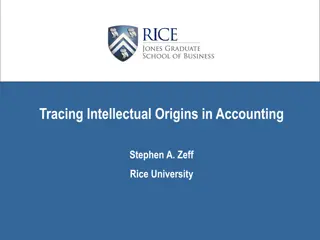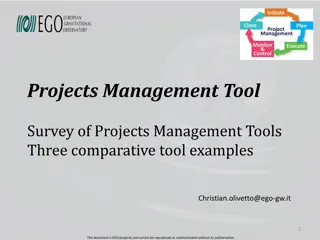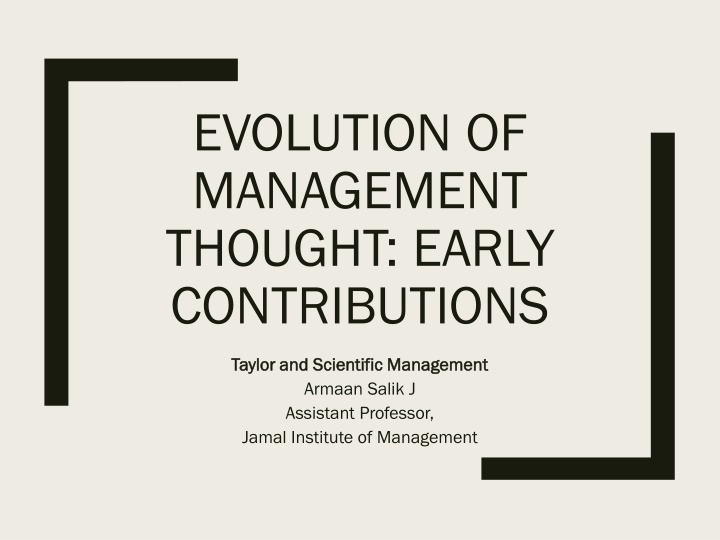
Evolution of Management Thought: Early Contributions by Taylor
Explore the impact of Taylor and Scientific Management in shaping modern managerial practices. Delve into the innovative techniques proposed by Taylor and their relevance in contemporary organizational structures. Gain insights into the foundation laid by Taylor in the realm of management theories.
Download Presentation

Please find below an Image/Link to download the presentation.
The content on the website is provided AS IS for your information and personal use only. It may not be sold, licensed, or shared on other websites without obtaining consent from the author. If you encounter any issues during the download, it is possible that the publisher has removed the file from their server.
You are allowed to download the files provided on this website for personal or commercial use, subject to the condition that they are used lawfully. All files are the property of their respective owners.
The content on the website is provided AS IS for your information and personal use only. It may not be sold, licensed, or shared on other websites without obtaining consent from the author.
E N D
Presentation Transcript
EVOLUTION OF MANAGEMENT THOUGHT: EARLY CONTRIBUTIONS Taylor and Scientific Management Taylor and Scientific Management Armaan Salik J Assistant Professor, Jamal Institute of Management
Introduction to Management Thought Introduction to Management Thought Management is the process of planning, organizing, leading, and controlling an organization's resources to achieve specific goals efficiently and effectively. It involves coordinating human, financial, and material resources to maximize productivity and achieve organizational objectives. Importance of studying the evolution of management thought Importance of studying the evolution of management thought Understanding the historical development of management thought provides valuable insights into the principles and practices that shape modern management. It allows us to: 1. Recognize the contributions of early theorists and how their ideas have influenced contemporary management practices. 2. Appreciate the context in which different management theories emerged and evolved. 3. Apply proven principles and practices to current management challenges. 4. Avoid repeating past mistakes by learning from the successes and failures of previous management approaches. 5. Foster continuous improvement and innovation in management practices by building on established foundations.
Early Contributors to Management Early Contributors to Management Pre-Industrial Revolution: Before the Industrial Revolution, management practices were informal and largely based on traditions. Work was organized by family units, apprenticeships, and guilds. Industrial Revolution: The advent of the Industrial Revolution in the late 18th century brought about significant changes in the way work was organized and managed. Factories and large-scale enterprises required more formal and systematic management approaches. Frederick W. Taylor (1856-1915): Known as the father of Scientific Management, was a mechanical engineer who sought to improve industrial efficiency. Significance: Taylor's work laid the foundation for modern management practices by emphasizing the application of scientific methods to analyze and improve work processes. Key Contributions: Taylor's principles of scientific management, time and motion studies, and his emphasis on efficiency and productivity revolutionized the way work was managed and organized.
Frederick Winslow Taylor Key Contributions to Management: Father of Scientific Management: Pioneered the study of work processes and efficiency Time and Motion Studies: Introduced systematic analysis of tasks to optimize performance The Principles of Scientific Management: Published in 1911, laid the foundation for modern management practices Advocate for Efficiency: Emphasized the importance of training, standardization, and the scientific approach to work Development of Management Practices: Introduced the concept of functional foremanship, separating planning from execution in work tasks Impact on Productivity: Demonstrated significant productivity gains through his methods, influencing various industries Notable Achievements: Increased Output: Successfully increased productivity at Bethlehem Steel by implementing his principles Systematic Training: Developed methods for training workers to perform tasks more efficiently Management Philosophy: Advocated for a harmonious relationship between workers and management through cooperation and mutual interest
Time and Motion Studies It involve the systematic observation, analysis, and measurement of the separate steps in performing a job to establish the most efficient method of working. The MAIN GOAL is to increase productivity by minimizing time wastage and optimizing work processes. Importance in improving efficiency : Work Simplification: By breaking down tasks into smaller components, it's possible to identify and eliminate unnecessary movements and steps. Standardization: Establishing standard times for tasks ensures consistency and efficiency across the organization. Resource Allocation: Helps in optimal allocation of resources, including labor and machinery, to enhance productivity. Examples of implementation Bricklaying: Frank and Lillian Gilbreth, contemporaries of Taylor, applied motion study techniques to bricklaying, reducing the number of motions required from 18 to 5, thus significantly increasing efficiency. Manufacturing Industry: Assembly line optimization, such as in the automotive industry, where tasks are broken down and streamlined to reduce time and motion wastage.
Principles of Scientific Management Science, not rule of thumb : Replace traditional methods with scientific techniques to determine the most efficient way of working. Ex: Conducting experiments to find the best way to perform a task. Harmony, management and workers to improve productivity and job satisfaction. Ex: Developing systems that encourage cooperation and reduce conflicts. not discord : Ensure harmonious relations between Cooperation, not individualism : Foster a collaborative environment where management and workers support each other. Ex: Implementing systems that promote teamwork and collective problem- solving. Development of each person to their greatest efficiency and prosperity : Train and develop workers to their fullest potential to enhance efficiency and job satisfaction. Ex: Providing ongoing training and development programs for employees.
Advocate for Efficiency 1. Importance of Training: Taylor championed the idea that work processes should be scientifically analyzed and standardized. He believed that training workers to perform tasks in the most efficient manner was crucial. Taylor's approach involved: I. Time Studies: Analyzing how long it took to complete specific tasks to establish the most efficient methods. II. Standard Procedures: Developing standardized procedures based on these studies to ensure that every worker performed tasks in the most efficient way possible. III. Training Programs: Implementing training programs to teach workers these standardized methods, ensuring consistency and efficiency. 2. Standardization: Taylor's focus on standardization was aimed at improving efficiency and reducing variability in work performance. By standardizing tools, procedures, and tasks, he believed that: I. Consistency: Workers would produce uniform results, making it easier to manage and predict output. II. Quality Control: Standardization would lead to higher quality and fewer errors, as every worker would follow the same procedures.
3. Scientific Approach: Taylors scientific management approach involved applying scientific methods to management and work processes. This included: I. Systematic Observation: Observing and analyzing work processes to find the best methods. II. Data-Driven Decisions: Using data from these observations to make informed decisions about work processes and efficiency. III. Objective Measurement: Measuring performance objectively to identify areas for improvement.
Development of Management Practices Development of Management Practices Functional Foremanship: Functional Foremanship: One of Taylor's key contributions was the concept of functional foremanship, which aimed to improve efficiency by separating planning from execution. This approach involved: 1. 1. Separation of Roles: Separation of Roles: Dividing the roles of planning and execution between different individuals. For example, one person would be responsible for planning the work and another for executing it. 2. 2. Specialization: Specialization: Assigning specific tasks to different foremen who specialized in areas such as quality control, work methods, and training. This specialization allowed for a more focused and efficient management of work processes. 3. 3. Enhanced Supervision: Enhanced Supervision: Functional foremanship aimed to provide better supervision and support for workers, ensuring that they had the guidance and resources needed to perform tasks efficiently.
Impact on Productivity 1. Demonstrated Productivity Gains: 1. Demonstrated Productivity Gains: Taylor s methods led to significant productivity gains in various industries, demonstrating the effectiveness of his approach. For instance: Manufacturing: Manufacturing: Taylor s work with companies like Bethlehem Steel showed that his methods could dramatically increase production rates. By optimizing work processes and reducing waste, productivity in steel production increased significantly. Process Improvement: Process Improvement: His principles led to the development of more efficient manufacturing processes, which were adopted by other industries, contributing to overall economic growth. 2. Influence on Various Industries: 2. Influence on Various Industries: Taylor s principles had a wide-ranging impact, influencing industries beyond manufacturing, including: Service Industries: Service Industries: Concepts from Scientific Management were adapted to improve efficiency in service industries, such as retail and hospitality. Management Practices: Management Practices: His emphasis on efficiency and data-driven decision-making influenced modern management practices, including operations management, quality control, and human resource management.
Criticisms of Scientific Management 1. Overemphasis on Efficiency : Critics argue that Scientific Management focuses excessively on efficiency and productivity, often at the expense of worker satisfaction and well-being. The approach can lead to monotonous tasks and reduced job satisfaction due to its rigid structures. 2. Dehumanization : The approach treats workers as mere cogs in a machine rather than as individuals with unique needs and motivations. This dehumanization can lead to decreased morale and reduced engagement among employees. 3. Limited Consideration of Human Factors : Scientific Management often neglects the social and psychological aspects of work. It tends to emphasize quantifiable aspects of performance while ignoring factors like teamwork, motivation, and organizational culture. 4. Inflexibility : The methods and processes defined by Scientific Management can be rigid and inflexible. This rigidity can hinder innovation and adaptation to changing conditions, as the focus is often on adhering to standardized procedures
5. Implementation Challenges : The principles of Scientific Management may be difficult to implement effectively in practice. The focus on precise measurement and control can be challenging to achieve and maintain, especially in complex or dynamic work environments. 6. Economic Efficiency Over Other Values : Emphasizing economic efficiency might overshadow other important values such as ethical considerations, environmental impact, and social responsibility. 7. Neglect of Worker Creativity : The approach often undervalues the role of creativity and problem-solving skills among workers. By focusing on predefined tasks and procedures, it may limit opportunities for workers to contribute innovative ideas. 8. Potential for Exploitation : The drive for efficiency can sometimes lead to exploitation of workers, with increased pressure and unrealistic performance expectations, potentially resulting in burnout and health issues.
Legacy of Taylor and Scientific Management Long Long- -term impact on management practices term impact on management practices 1. Standardization and Efficiency : Taylor's principles of standardizing work processes and focusing on efficiency have become foundational in many industries. The emphasis on optimizing workflows, reducing waste, and improving productivity continues to shape operational strategies. 2. Time and Motion Studies : Taylor s method of analyzing tasks through time and motion studies laid the groundwork for systematic approaches to improving work efficiency. This practice is still prevalent in fields such as manufacturing and logistics, where optimizing processes remains critical. 3. Scientific Approach to Management : The introduction of a scientific approach to management using data and empirical methods to make decisions has influenced how organizations analyze performance, set goals, and implement improvements. 4. Worker Selection and Training : Taylor s emphasis on selecting the right people for specific tasks and training them to perform efficiently has influenced modern human resource practices. This approach underscores the importance of skill matching and ongoing training in workforce development.
Influence on modern management theories 1. Operations Management : The principles of Scientific Management have greatly influenced operations management, which focuses on optimizing production processes, quality control, and supply chain management. Concepts such as Lean Manufacturing and Six Sigma are built on similar principles of efficiency and process improvement. 2. Human Resources Management : While Scientific Management is often criticized for its dehumanizing aspects, its focus on performance metrics and training has influenced HR practices, particularly in areas such as performance evaluation, training programs, and job design. 3. Management by Objectives (MBO) : The MBO approach, which emphasizes setting specific, measurable goals for employees, aligns with Taylor s focus on clear objectives and performance metrics. This theory stresses the importance of aligning individual goals with organizational objectives. 4. Quantitative Management : Modern management theories that involve quantitative approaches to decision-making, such as Operations Research and Management Science, draw on Taylor s emphasis on using scientific methods to solve management problems.
Integration into Contemporary Practices 1. Lean and Agile Methodologies : Contemporary practices such as Lean and Agile methodologies incorporate elements of Taylor s Scientific Management but with a greater focus on flexibility, employee involvement, and continuous improvement. Lean, for example, focuses on eliminating waste while Agile emphasizes iterative improvements and team collaboration. 2. Data-Driven Decision Making : The use of data analytics in contemporary management practices reflects Taylor s influence. Organizations now leverage big data and advanced analytics to drive decisions, optimize processes, and enhance productivity. 3. Technology Integration : Modern technologies, such as automation and digital tools, have evolved from Taylor s focus on efficiency. These technologies streamline processes, improve accuracy, and enhance productivity, reflecting the enduring impact of Scientific Management principles. 4. Focus on Employee Engagement : While Taylor s approach was criticized for its lack of emphasis on employee well-being, contemporary practices have integrated his efficiency principles with strategies to boost employee engagement, job satisfaction, and work-life balance.
THANK YOU! THANK YOU!



